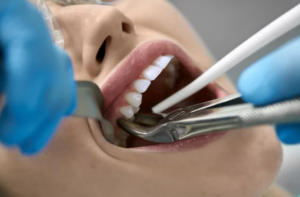Sometimes a tooth gets too damaged or decayed to save, and your dentist may need to remove it. While dentists always try to save your natural teeth, pulling a tooth is sometimes the best way to stop pain or prevent infection. Fortunately, the procedure is quick and straightforward.
But what happens after is just as important. Taking care of your mouth properly helps you heal faster and keeps you comfortable. This guide will walk you through what to expect after an extraction and how to make your recovery as easy as possible. With the right care, you’ll be feeling better in no time.

The First 24 Hours After Your Tooth Extraction
Right after your dentist removes your tooth, they’ll give you some gauze to bite down on. This helps stop the bleeding. You’ll need to keep the gauze in place for about 30 to 45 minutes, or until the bleeding slows down.
When you take the gauze out, your mouth might feel a little swollen and sore, but don’t worry. Regular pain medicine you can buy at any store and ice packs will help you feel better.
During this first day, take it easy. Running around or playing sports could make your mouth bleed more or hurt worse. There are two very important things to avoid: smoking and drinking through straws. The sucking motion can knock loose the blood clot that forms where your tooth used to be.
If that happens, you could get something called a dry socket, which really hurts and could lead to an infection. A dry socket happens when the blood clot that normally forms in the empty tooth socket either falls out or dissolves too soon. Without this protective clot, the sensitive nerves and bone underneath get exposed to air, food, and bacteria. This exposure causes intense, throbbing pain that often starts a few days after the extraction and can even radiate to your ear or neck.
Not only is the pain severe, but a dry socket also leaves the area vulnerable to infection since there’s no protective barrier. Bacteria can easily get into the open socket, which might lead to swelling, bad breath, or even fever.
The good news is your dentist can help by cleaning the socket and placing special medicated dressing to relieve pain and promote healing. Be sure to follow all your dentist’s aftercare instructions carefully to avoid this painful complication, especially about not smoking or using straws.
Taking Care of Your Mouth After the First Day
Once you’ve made it through the first 24 hours, you’ll need to keep the area clean while it heals. You can brush your teeth like normal, but be extra gentle near the spot where your tooth was taken out. Don’t use mouthwash right away because the alcohol in it can bother the healing area.
After the first day, you can start using a saltwater rinse to keep your mouth clean. Making the rinse is easy. Just mix one teaspoon of regular table salt into a cup of warm water. Very gently swish it around in your mouth for about 30 seconds before spitting it out. Doing this a few times a day will help reduce swelling and keep germs away.
What to Eat While You Heal
For the first few days, stick to soft foods that don’t need much chewing. Things like yogurt, pudding, mashed potatoes, and smoothies are perfect. Stay away from crunchy snacks like chips, sticky foods like gum or caramel, and anything that’s really hard to chew. These kinds of foods could poke or irritate the healing spot in your mouth.
Remember, your mouth just needs some time to heal properly. If you follow these simple steps, you’ll be back to normal in no time. If you have any questions or if something doesn’t seem right, don’t hesitate to call your dentist. They can help make sure your healing goes smoothly.
The most important things to remember are to keep the area clean, eat soft foods, and avoid anything that might bother the healing spot. Before you know it, your mouth will feel much better and you’ll be able to eat all your favorite foods again. Just be patient and give your body the time it needs to heal properly.
Pay Attention
After getting a tooth pulled, your mouth needs time to heal properly. While some discomfort is normal, you shouldn’t have really bad pain that won’t go away. If you suddenly get extreme pain days after the procedure, contact our dentists right away. This could mean you have an infection or other problem that needs treatment.
Also keep an eye out for these warning signs:
- Fever (your body feels hot when you shouldn’t be sick)
- Bad-smelling liquid coming from where the tooth was
- Swelling that gets worse instead of better
Don’t wait if you notice any of these things. The sooner we can check it, the faster you’ll feel better. Remember, most people heal just fine if they follow the care instructions. But it’s always better to call us if something doesn’t seem right. To learn about our tooth extraction services, see Tooth extraction.

